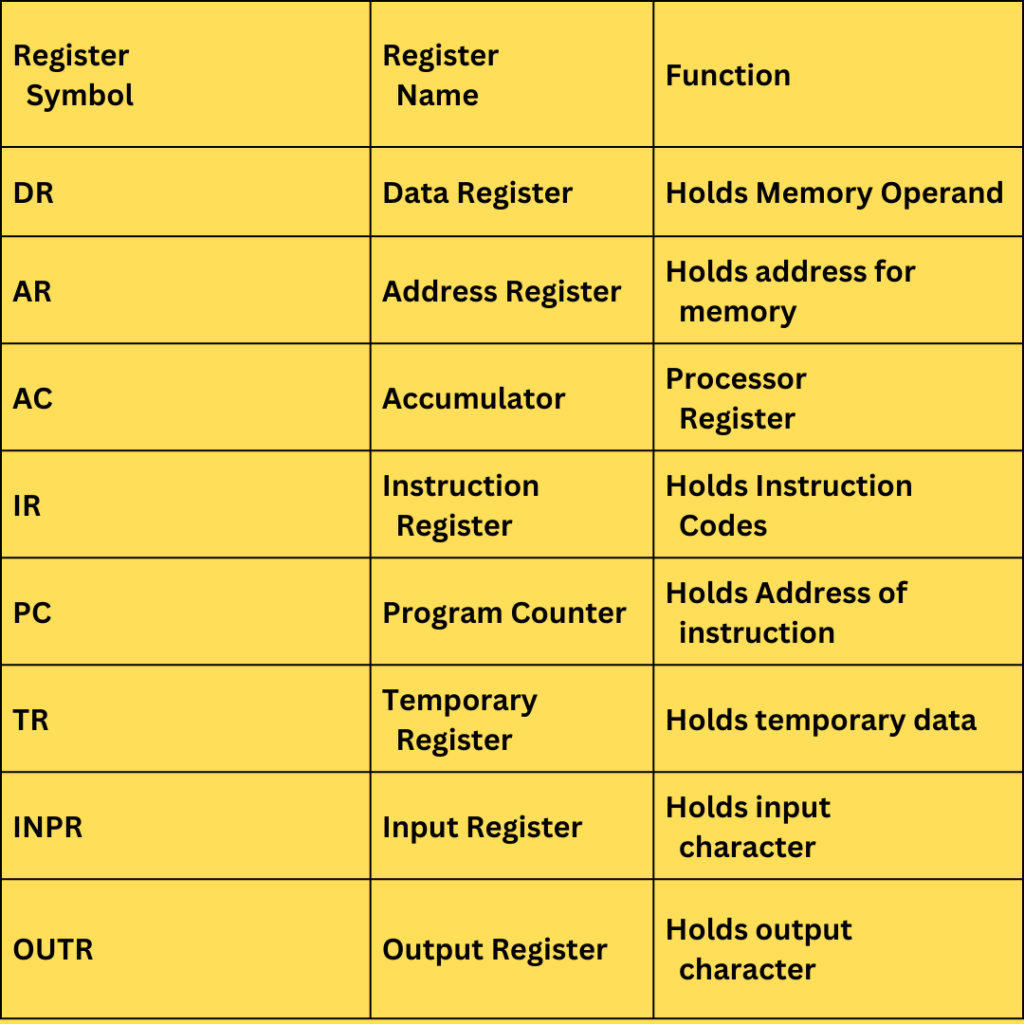BCS302: Registers in Computer Architecture| Types of Registers
Registers are essential components of the CPU in computer organization, serving as temporary storage for data and control information.
There are several types of registers, each serving a specific purpose within the central processing unit (CPU).
These registers facilitate various operations, including data storage, control, and data manipulation.

Here are the different types of registers commonly found in computer:
-
Data Registers:
- Data registers, also known as general-purpose registers, are used for storing data that is being processed or manipulated by the CPU. These registers are often used for arithmetic and logical operations.
- Examples: Accumulator, Data Registers (R0, R1, R2, etc.).
-
Control Registers:
- Control registers store control information that affects the behavior of the CPU and the execution of instructions. They are used to configure and manage the CPU’s operation.
- Examples: Program Counter (PC), Instruction Register (IR), Status Register (PSW), Program Status Word (PSW).
-
Program Counter Register:
- The Program Counter (PC) register holds the memory address of the next instruction to be executed. It helps in maintaining the sequence of program execution.
- Example: Program Counter Register.
-
Instruction Pointer Register:
- The Instruction Pointer (IP) register is used in some CPU architectures to store the memory address of the next instruction to be executed, similar to the PC in x86 architecture.
- Address Registers:
- Address registers store memory addresses or pointers. They are used for accessing specific locations in memory, such as when fetching data or instructions.
- Examples: Memory Address Register (MAR), Index Registers.
-
Stack Pointer Register:
- The Stack Pointer (SP) register keeps track of the top of the stack in memory. It is used for managing the stack, which is important for function calls and data storage.
- Example: Stack Pointer Register
-
Memory Buffer Register:
- The Memory Buffer Register (MBR) is used for temporary storage of data during data transfer between the CPU and memory. It acts as a buffer.
- Example: Memory Buffer Register.
-
Input/Output Registers:
- Input/Output (I/O) registers are used to interface with peripheral devices. They facilitate data transfer between the CPU and external devices.
- Examples: Input Register (IN), Output Register (OUT).
The specific types and number of registers in a CPU can vary depending on the architecture and design of the processor. Different registers serve different functions, enabling efficient data processing, memory access, and control within the CPU.

Important questions on Register in computer organization?
1. What is a register in computer organization?
- A register is a small, high-speed storage location within the central processing unit (CPU) of a computer. It is used for temporary data storage, control, and data manipulation.
2. How many types of registers are there in a CPU?
- CPUs typically have several types of registers, including general-purpose registers, special-purpose registers, control registers, and flag registers.
3. What are general-purpose registers used for?
- General-purpose registers can hold various types of data and are used for arithmetic and logical operations, data storage, and addressing memory locations.
4. What is the purpose of the Program Counter (PC) register?
- The Program Counter (PC) keeps track of the memory address of the next instruction to be executed in the program. It ensures sequential instruction execution.
5. How do registers facilitate arithmetic operations in a CPU?
- Registers store operands and intermediate results during arithmetic operations, allowing the CPU to perform calculations efficiently.
6. What role do flag registers play in CPU operations?
- Flag registers store condition codes or status flags that provide information about the results of operations. They are essential for program flow control and decision-making.
7. Can registers store both data and instructions?
- Yes, registers can store both data and memory addresses, including instructions. They hold the values needed for CPU operations.
8. How is data transferred between registers and memory?
- Data is transferred between registers and memory using memory address registers (MAR) and memory buffer registers (MBR), which facilitate read and write operations.
9. What is the significance of the Stack Pointer (SP) register?
- The Stack Pointer register keeps track of the top of the stack in memory. It is crucial for managing function calls, local variables, and program flow control.
10. Do all CPU architectures have the same number and types of registers?
– No, CPU architectures can vary in the number and types of registers they use. Different architectures are designed to meet specific performance and functionality goals.
11. How do registers contribute to CPU performance?
– Registers enable fast data access and manipulation, reducing the need to access slower memory locations frequently. This contributes to overall CPU speed and efficiency.
12. Can registers be accessed directly by programmers in high-level languages?
– In some programming languages and assembly languages, programmers can access registers directly for specific tasks, but this access is often abstracted by the compiler or language runtime.
13. What happens to register contents during context switches in multitasking operating systems?
During context switches between tasks or processes, the contents of registers are typically saved and restored to ensure that each task continues correctly from where it left off.
14. Are there any limitations to the number of registers in a CPU?
– Yes, there are practical limitations to the number of registers due to factors like chip size, complexity, and cost. CPU designers must strike a balance between the number of registers and overall CPU performance.
15. How do SIMD (Single Instruction, Multiple Data) registers differ from general-purpose registers?
SIMD registers are specialized for vector processing and can perform operations on multiple data elements simultaneously. General-purpose registers are more versatile but operate on individual data elements.
0 Comments